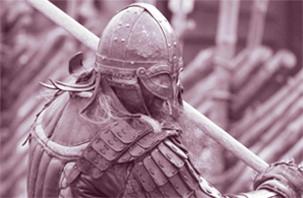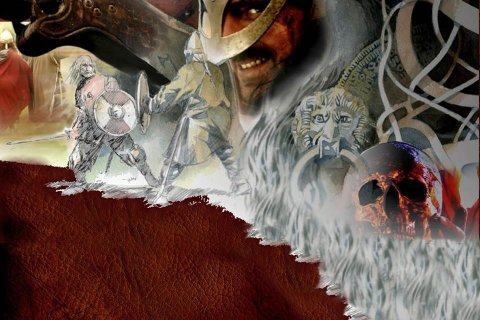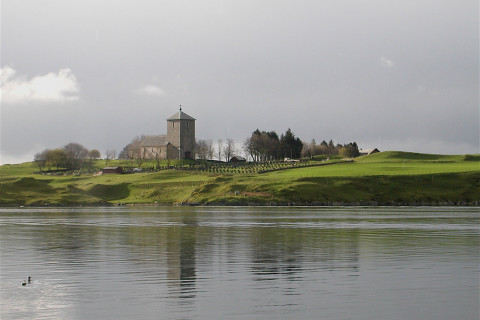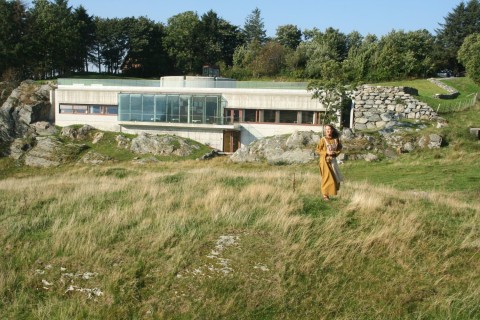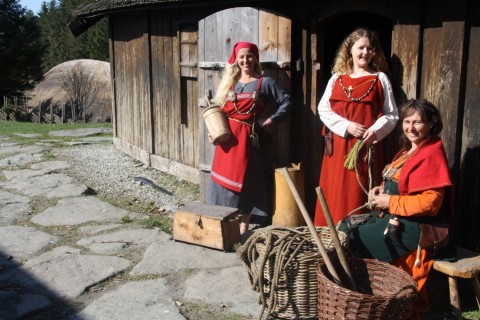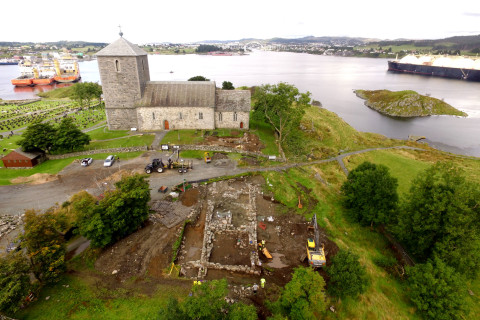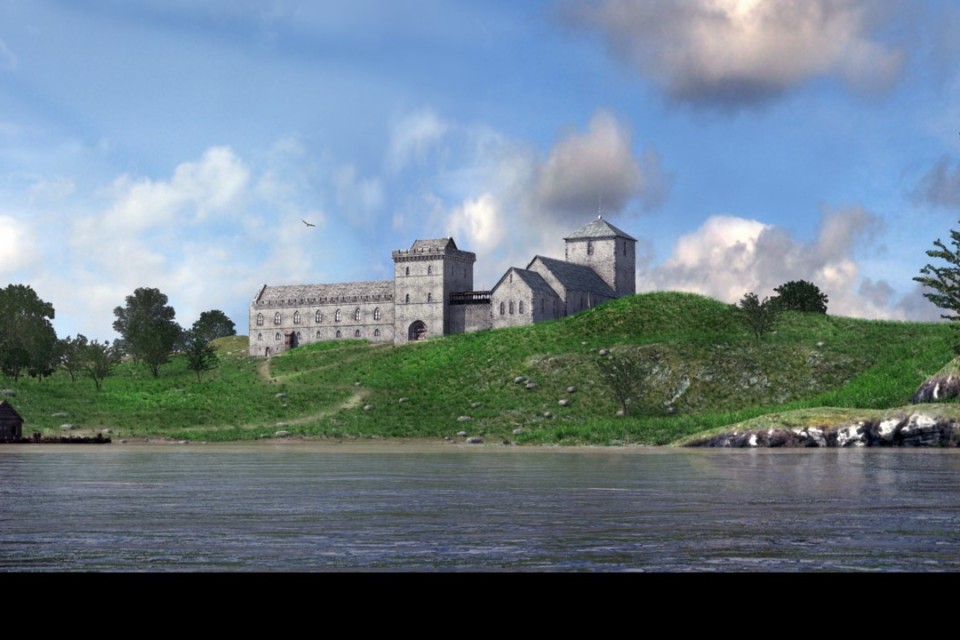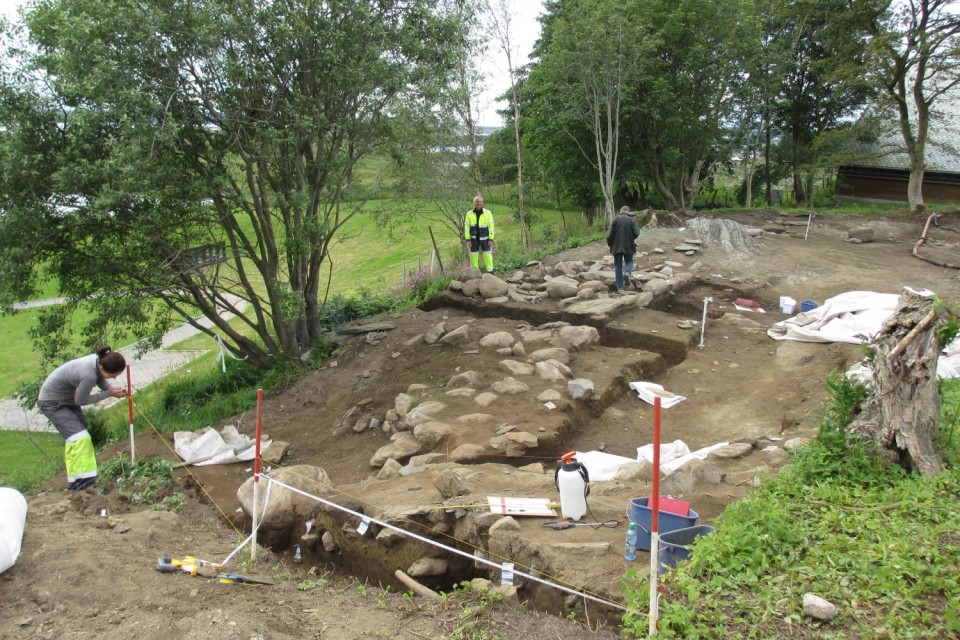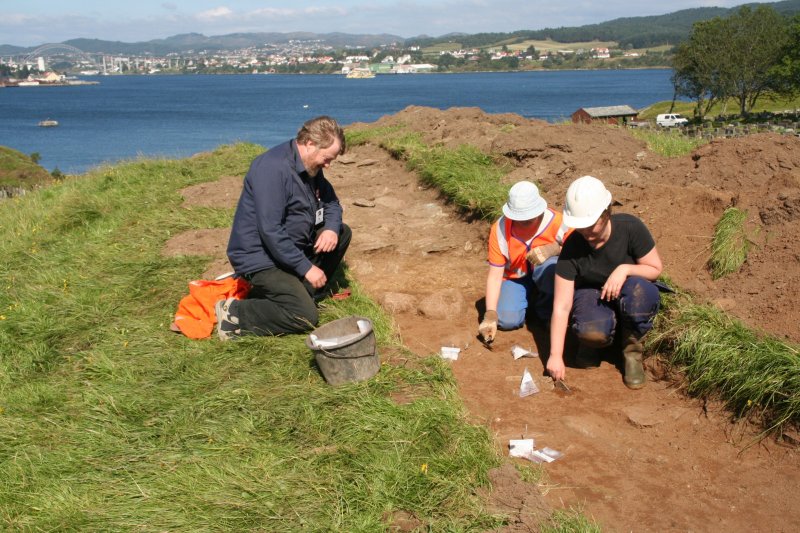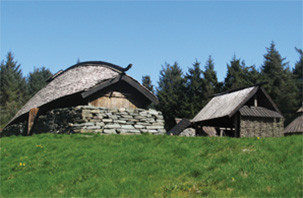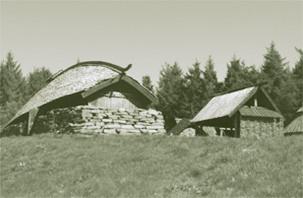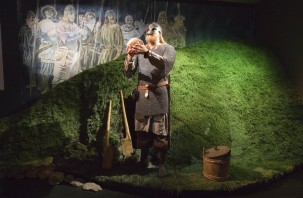Research
Text Marit Synnøve Vea

In 2006. Archaeological Museum, UiS finds traces of settlement from the Viking Age / Early Medieval Age south of the church. (Photo Marit Synnøve Vea)
Since the Avaldsnes Project was established in 1993, it has been a goal to initiate research and exploration of the royal manor area. We wanted to gain new knowledge by examinining the soil, the sea and the archives.
EXAMINATIONS ON LAND IN COOPERATION WITH THE ARCHAEOLOGICAL MUSEUM, UiS
During the period 1992-2006 the Archaeological Museum in Stavanger did a number of test excavations and registrations. The purpose was to find out:
– Which kind of archaeological material is preserved in the ground?
– Which of this archaeologist material can give us the most knowledge about the royal seat at Avaldsnes?
– What are the most in danger of being destroyed?
AVALDSNES ROYAL MANOR PROJECT
The Avaldsnes Royal Manor project was established in 2007. The project is led by Professor Dagfinn Skre, Museum of Cultural History in Oslo. The project is a collaboration between the Museum of Cultural History UiO, Karmøy Municipality, Archaeological Museum UiS, Rogaland County Municipality, University of Cambridge and NIKU.
See separate pages: KONGSGÅRDPROSJEKTET AVALDSNES
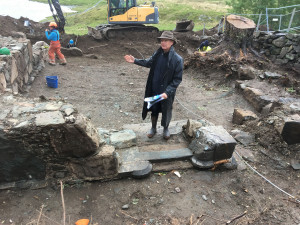
Dagfinn Skre inside the gate tower. The nicely curved stones at the bottom of the doorway are similar to those in St. Olaf’s church. This may indicate that Håkon Håkonsson built the tower at the same time as he built the church. (Photo Marit S. Vea).
The Royal Manor project is based on test excavations conducted by the Archaeological Museum, University of Stavanger in the period 1992-2006.
THE AIM OF THE AVALDSNES ROYAL MANOR PROJECT
The Royal Manor project should initially investigate the story of the royal seat Avaldsnes and the rise of the Norwegian kingdom from approx. 200 to 1100 AD. During the excavations in 2012, the archaeologists made the unexpected discovery of a medieval royal manor built in stone. The Royal Manor project therefore expanded its thematic and chronological framework to include the institutionalized kingdom of the High Middle Ages.
For reason of safety the medieval walls were covered up until a carefully planned scientific excavation could be carried out.
In December 2016 the Norwegian government granted NOK 5.4 million for the medieval ruins at Avaldsnes. Thus, the project was fully funded and the excavation of the royal estate could start in June 6th, 2017

Approx. 25 m of the royal building is uncovered outside the cemetary, but it continues towards St Olaf’s church. The main building is 51 m long, included the tower. (Photo Marit Synnøve Vea)
2017. EXCAVATIONS OF A ROYAL MANOR
From 6 June to 13 October, the Royal Manor project excavated the medieval ruins found on the plateau south of St Olaf’s church in 2012. As the excavations progressed, the archaeologists found much more masonry than anyone had expected, and the excavations reviled that this was the ruins from the main building of the medieval royal estate.
The main building had three floors built in stone, included the cellar. The cellar was used as a storage room, probably to store goods received from both taxation and trade.
On the second floor, there were kitchens, workshops and working rooms. On the third floor was the representative hall and other rooms used by the king when he was at Avaldsnes.
The building ended in a high gate tower. This was the main entrance to the royal manor. From the tower a covered passageway, perhaps in two floors, leaded up to the chancel. The façade from the south to the church was 70 m. The main building, including the tower, was about 51 meters
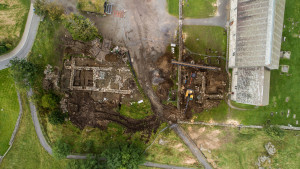
The ruins of the Royal Manor seen from above. (Photo Austevik Dronefoto)
WHO BUILT THE MEDIEVAL ROYAL MANOR?
The building was constructed sometime between 1240-1319, probably either by Håkon Håkonsson, who built the Church of St Olaf, or by Håkon V Magnusson, who appointed St Olaf’s church as a collegiate church. So far, it seems that the gate tower was built by Håkon Håkonsson at the same time as the church, and that Håkon V Magnusson continued with the main building which was completed sometime around 1300.
Most medieval ruins in Norway are sacral buildings such as churches and monasteries. Only three other medieval royal manors are known in Norway. They are located in Oslo, Bergen and Tønsberg. The discovery of this royal manor shows that also the medieval kings invested heavily in Avaldsnes.
3D MODEL OF THE MEDIEVAL RUIN
Read more about Avaldsnes in the medieval times

Avaldsnes seen from southwest. Reconstruction based on the excavations conducted by the Royal Manor project. Ill. ARKIKON v/Ragnar Børsheim
CONSERVATION OF THE RUINS
The ruins are currently covered by a temporary building that will protect the walls until the conservation is finished. The conservation will be done in close cooperation with NIKU. (The Norwegian Institute for Cultural Heritage Research) and it will take several years before it is finished. The conservation will enable the ruin to withstand wind and wear and tear.
The ruins, together with St Olaf’s Church, will be the significant elements in a medieval park that will be developed in the central church area.
The landscape around the ruin will be arranged so that the audience can walk around it. We will also provide information on how the royal estate may have looked and how the buildings were used.
THE AVALDSNES ROYAL MANOR PROJECT HAS THREE PHASES
Preparatory project: Completed 2007-2009.
Excavation phase: Excavations conducted summer seasons of 2011, 2012 and 2017.
Analysis and publication phase: 2013 – 2019: During this phase, a team of prominent researchers are working on writing Avaldsnes’ history from the birth of Christ to the High Middle Ages.The research team will also place Avaldsnes in a context that makes the farm’s more than a thousand year long history as a royal residence understandable and meaningful; locally,nationally and internationally.
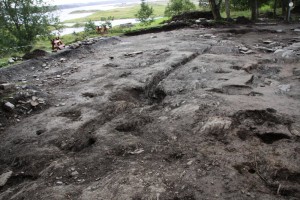
2012, The Royal Manor Project finds a wall-trench of a hall built in the late Roman period. In the wall-trench is also postholes from a building, probably a hall, erected in the Viking Age. (Photo Cathrine Glette)
Publications from the Avaldsnes Royal Manor project:
«Avaldsnes – A Sea-Kings’ Manor in First-Millennium Western Scandinavia». (2018)
«Rulership in 1st to 14th-century Scandinavia. Royal graves and sites at Avaldsnes and beyond» (2019)
See also:
Norðvegr – Norway: From Sailing Route to Kingdom. Prof Dagfinn Skre
From Kaupang and Avaldsnes to the Irish Sea. Prof. Dagfinn Skre
2017. THE NATIONAL GOVERNMENT GRANTS NOK 10 MILL TO THE AVALDSNES ROYAL MANOR PROJECT
In May 2017, the National Government granted NOK 10 million for the analysis and publication phase of the Avaldsnes Royal Manor project. This makes it possible to write Avaldsnes’s history into a broader European context. Ie a story about how the Germanic tribes of northern Europe were transformed into kingdoms and eventually states.
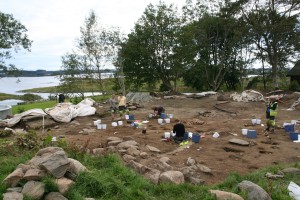
2012. “Workshop” area for forging, handicraft, grain drying, salt production etc. In use from 200 – 1000 AD.(Photo Ørjan Iversen)
STUDIES IN THE SEA IN COOPERATION WITH STAVANGER MARITIME MUSEUM
Since 1998, Stavanger Maritime Museum has conducted marine archaeological investigations in the harbour area at Avaldsnes. Archaeological Museum, Stavanger has also been involved in investigating structures on land that may be related to harbour activities.
There have been many exciting and important discoveries both on land and in the sea, especially from the Hanseatic period. The Hanseatic presence at Avaldsnes was from about 1350 to 1500. In November 2012 marine archaeologists set out to find the geographical boundaries of the Hanseatic harbour area at Avaldsnes. They found instead the outer harbour of The Royal Manor’s activities. Until now we can follow this back to the 1100s. We do not know yet the extension of this royal harbour.
In 2009, the “Harbour Project” at Avaldsnes was connected with the project “HANSA: The Hanseatic Expansion in the North Atlantic”, a collaboration between the University of Vienna and Queen’s University in Belfast.
See: German trade in the North Atlantic (c. 1400-1700). Eds. N. Mehler, M. Gardiner, E. Elvestad (2019)
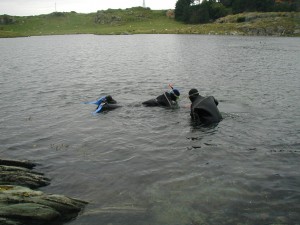
In 2000 Stavanger Maritime Museum found a 22m long clinker built ship from the 14th century. The ship is located in the shallow area we call “The Kings’ Harbour”. (Photo Marit Synnøve Vea)
RESEARCH PROJECT: AVALDSNES – THE PORT OF POWER (AVALDSNES – MAKTENS HAVN)
June 2019, the research project Avaldsnes – The Port of Power was launched at Avaldsnes. The project combines archeology and technology from the offshore industry in a research study that will provide new knowledge about which role the harbour area played for the maritime power center Avaldsnes for over 3000 years.
The project is a cooperation between Stavanger Maritime Museum, the Archaeological Museum, University of Stavanger, The Avaldsnes Project, Saga Subsea and Geopluss.
The project aims to investigate the port area at Avaldsnes, large burial monuments along the Karmsund strait and ship finds both on land and at sea.
Two doctoral projects are associated with the project: An industry PhD, funded by the Research Council of Norway, which deals with the use of geophysical methods from the oil service industry to map the extent of archaeological traces on the seabed.
The second PhD, funded by the Museum of Archaeology, will look at the role the Karmsund region played in the development of Viking ship technology. Karmøy’s ship burials, Storhaug and Grønhaug, are very central here.
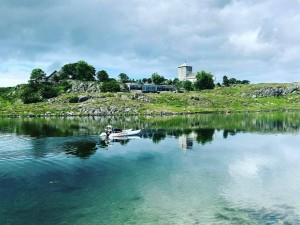
June 2021. The Department of Energy Resources at UiS maps the Iron Age and Medieval ports at Avaldsnes using geophysical methods. (Photo Hallgjerd Ravås)
From 2020 – 2022, the Port of Power project has been at Avaldsnes a number of times to carry out geophysical surveys both on land and at sea. They have mapped and documented what is visible on the ground surface, and collected data from the seabed to create a plan for further investigation of the ports used by the kings’ at Avaldsnes and by the Hanseatic League.
Spring 2022, the project received a donation from Per Sand who has worked with shipping all his life. The donation made it possible to initiate a preliminary project for investigations of the Storhaug ship burial, which is Scandinavia’s oldest ship grave.
The donation will also be used to research more on the Vikings’ ship technology, archaeological investigations underwater and on land in the port area and for examination of graves.
In June 2022, the Archaeological Museum conducted the first investigations of the ship burial Storhaug.The preliminary project carried out both geophysical surveys and archaeological test excavations. The preliminary project will form the basis for assessing further investigations and a possible reconstruction of the burial mound.
TORMOD TORFÆUS FOUNDATION
Originally the Avaldsnes project had the translation of Tormod Torfæus’ “Historia rerum Norvegicarum” on the program. Torfæus’ volumes were the first comprehensive presentation of Norwegian history since Snorri Sturluson’s Heimskringla.
This work was very extensive, and in 2001 a separate “Tormod Torfæus Foundation” was established. The main goal for the foundation was to translate “Historia rerum Norvegicarum” from Latin to Norwegian. In november 2014 the last two of seven volumes was released at a seminar in The National Library of Norway.
COMMUNICATION OF NEW KNOWLEDGE
Communication has been – and will be – important for the Avaldsnes project. It has been a stated goal that the knowledge we get through our research programmes, shall be communicated to a wide audience through exhibitions in Nordvegen History Center, historic seminars, books, articles, media etc.
We have also established a “RESEARCH ROOM” in Nordvegen History Centre where we want to provide continuous dissemination of the new knowledge that emerges through inter alia the Avaldsnes Royal Manor Project and the Harbour Project.
PUBLICATIONS
Part of what is done through research and acquisition of new knowledge, will be popularized on these pages. For more in-depth information, see separate publications: Unfortunately, most of these are in Norwegian
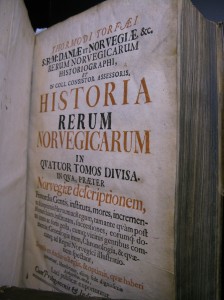
The Tormod Torfæus Foundation has translated seven volumes of the Historia rerum Norvegicarum from Latin to Norwegian. The volumes will also be available in English. (Photo Cathrine Glette)
BOOKS, PAPERS
De glemte skipgravene, Makt og myter på Avaldsnes (Arnfrid Opedal, AmS, 1998)
Kongens Død i et førstatlig rike. Skipsgravritualer i Avaldsnes-området og aspekter ved konstituering av kongemakt og kongerike 700-950 e.Kr. (Arnfrid Opedal, Doktorhgradsavhandling, UiO, 2005)
Kongemakt og kongerike. Gravritualer og Avaldsnes-områdets politiske rolle 600 – 1000. (Unipub, 2010)
Historier fra en annen virkelighet. Fortellinger om bronsealderen ved Karmsundet (Lise N. Myhre, AmS, 1998)
Trialectic Archaeology: Moments and space in Southwest Norway 1700 – 500 BC. (Lise N. Myhre, AmS 2004)
PUBLICATIONS FROM THE KARMØY SEMINARS:
Rikssamling og Harald Hårfagre, Karmøyseminaret 1993
Nordsjøen – handel, religion og politikk, Karmøyseminaret 1994/1995
Rikssamlingen – høvdingmakt og kongemakt, Karmøyseminaret 1996
Havn og handel i 1000 år, Karmøyseminaret 1997
Fiender og forbundsfeller – regional kontakt gjennom historien, Karmøyseminaret 1999
Skjulte havner – forhistoriske havneanlegg, Karmøyseminaret 2001
Den nordiske histories fader, Karmøyseminaret 2002
Mellom Vinland og Ringenes Herre, Karmøyseminaret 2004
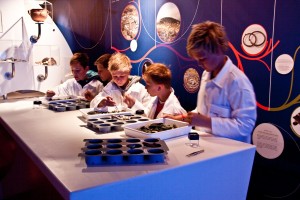
In Nordvegen History Centre you can learn about the research and excavations that have taken place at Avaldsnes. (Photo Cathrine Glette)
ARCHAEOLOGICAL REPORTS
Eit forskingsprosjekt på Avaldsnes, Rapport frå Arkeologisk museum i Stavanger, 1994. AmS, Red. Arnvid Lillehammer
Husøy – palaeoecology and prehistory of a small island in the SW coast of Norway, Ams 1997. Inge lindblom, AsbjørnSimonsen, Leiv Solheim,
Maritim-arkeologiske forundersøkelser av middelalderhavna på Avaldsnes, Karmøy. AmS 2001, Red. Endre Elvestad og Arnfrid Opedal
Rapport om Arkeologiske undersøkelser av tre gravanlegg og restaurering av en gravhaug på Avaldsnes prestegård, 2001, AmS (Ragnhild Sjurseike)
Rapport. Marinarkeologisk registrering, Stutøy og Midtøy, Karmøy kommune, 2003. Stavanger museum, Endre Elvestad
Avaldsnesprosjektet. Registreringer av Kongshaug og Gloppe 2005, Ams. Henriette Hafsaas
Avaldsnesprosjektet. Registreringer på prestegården Avaldsnes, 2006. AmS. Henriette Hafsaas
ROYAL MANOR PROJECT
Rapport Arkeologisk Utgraving, Kongsgårdprosjektet Avaldsnes, Egil Marstein Bauer og Mari Arentz Østmo, Kulturhistorisk museum, UiO, 2013
Avaldsnes – A Sea-Kings’ Manor in First-Millennium Western Scandinavia. Ed. Dagfinn Skre. (2018)
Rulership in 1st to 14th-century Scandinavia. Royal graves and sites at Avaldsnes and beyond Ed. Dagfinn Skre(2019)
TORMOD TORFÆUS
Tormod Torfæus, ei innføring. Torgrim Titlestad, Erling Skjalgsonsselskapet 2001
Norges Historie, bind 1 – 7, (Norwegian translation of Historia rerum Norvegicarum) av Tormod Torfæus. Eide Forlag / Vigmostad & Bjørke AS
Last update November 2022
Back

